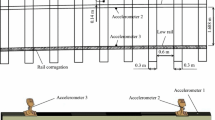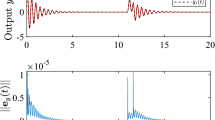Abstract
Operation safety and stability of the train mainly depend on the interaction between the wheel and rail. Knowledge of wheel/rail contact force is important for vehicle control systems that aim to enhance vehicle stability and passenger safety. Since wheel/rail contact forces of high-speed train are very difficult to measure directly, a new estimation process for wheel/rail contact forces was introduced in this work. Based on the state space equation, dynamic programming methods and the Bellman principle of optimality, the main theoretical derivation of the inversion mathematical model was given. The new method overcomes the weakness of large fluctuations which exist in current inverse techniques. High-speed vehicle was chosen as the research object, accelerations of axle box as input conditions, 10 degrees of freedom vertical vibration model and 17 degrees of freedom lateral vibration model were established, respectively. Under 250 km/h, the vertical and lateral wheel/rail forces were identified. From the time domain and frequency domain, the comparison of the results between inverse and SIMPACK models were given. The results show that the inverse mathematical model has high precision for inversing the wheel/rail contact forces of an operation high-speed vehicle.
Similar content being viewed by others
References
EVANS J, BERG M. Challenges in simulation of rail vehicle dynamics [J]. Vehicle System Dynamics, 2009, 47(8): 1023–1048.
XIA F, COLE C, WOLFS P. A method for setting wagon speed restrictions based on wagon responses [J]. Vehicle System Dynamics (Supplement), 2006(44): 424–432.
LECHOWICZ S, HUNT C. Monitoring and managing wheel condition and loading [C]// Proceeding of International Symposium for Transportation Recorders. Arlington, 1999: 205–239.
NIELSEN J. JOHANSSON A. Out of round railway wheels: Literature survey [C]// Proceedings of the Institute of Mechanical Engineers-Part F, London, 2002: 79–91.
CHUDZIKIEWICZ A. Selected elements of the contact problems necessary for investigating the rail vehicle system [C]// KISILOWSKI J, KNOTHE K, ed. Advanced Railway Vehicle System Dynamics, WNT, Warszawa, 1991: 97–108.
CHUDZIKIEWICZ A. Elements of vehicle diagnostics [M]. Radom: ITE, 2002: 30–36.
LAW S S, CHAN T H T. Moving force identification: A time domain method [J]. Journal of Sound and Vibration, 1997, 201(1): 1–22.
NORDSTRÖM L. Load identification using time domain methods [D]. Gothenburg: Chalmers University of Technology, 2003.
UHL T. Identification of operational loading forces for mechanical structures [C]// Proceedings of the 11th World Congress in Mechanism and Machine Science. Tianjin, China, 2004: 1–5.
UHL T. The inverse identification problem and its technical application [J]. Arch Appl Mech, 2007(77): 325–337
XIA F, BLEAKLEY S, WOLFS P. The estimation of wheel rail interaction forces from wagon accelerations [C]// 4th Australasian Congress on Applied Mechanics, Institute of Materials Engineering Australasia Ltd, 2005: 333–338.
XIA F, COLE C, WOLFS P. An inverse railway wagon model and its applications [J]. Vehicle System Dynamics, 2007, 45(6): 583–605.
XIA F, COLE C, WOLFS P. Grey box-based inverse wagon model to predict wheel-rail contact forces from measured wagon body responses [J]. Vehicle System Dynamics (Supplement), 2008(46): 469–479
HAMED R, HÅKAN J. A numerical framework for load identification with application to wheel-rail contact forces [C]// ECCOMAS International Symposium IPM, Ischia, 2009: 78–87.
TRUJILLO D M, BUSBY H R. Practical inverse analysis in engineering [M]. Boca Raton, FL: CRC Press LLC, 1997: 19–41.
BELLMAN R. Dynamic programming [M]. Princeton, NJ, Princeton University Press, 1957: 136–152.
HANSEN P C. Analysis of discrete ill-posed problems by means of the L-curve [J]. SIAM Rev, 1992(34): 561–580.
ZUO Y Y, XIANG J. Correlation analysis of track irregularities of Zhengzhou-Wuhan railway [J]. Journal of Railway Science and Engineering, 2006, 3(1): 46–49. (in Chinese)
ZHAI W M. Vehicle-track coupling dynamics [M]. Beijing: China Railway Publishing House, 2001: 17–23.
MA W H, LUO S H. Influence of the orientation stiffness of tumbler journal box to the stability of high speed vehicles[C]// 2010 International Conference on Computer Design and Applications. Qinhuangdao, China, 2010: 282–286.
Author information
Authors and Affiliations
Corresponding author
Additional information
Foundation item: Project(2009BAG12A04-A11) supported by the National Key Technology R&D Program in the “11-th Five-year Plan” of China; Projects(51275432, 51005190) supported by the National Natural Science Foundation of China; Project(SWJTU09ZT23) supported by University Doctor Academics Particularly Science Research Fund, China
Rights and permissions
About this article
Cite this article
Zhu, T., Xiao, Sn., Ma, Wh. et al. Research of inverse mathematical model to high-speed trains. J. Cent. South Univ. 21, 428–438 (2014). https://doi.org/10.1007/s11771-014-1956-x
Received:
Accepted:
Published:
Issue Date:
DOI: https://doi.org/10.1007/s11771-014-1956-x




